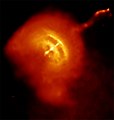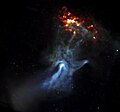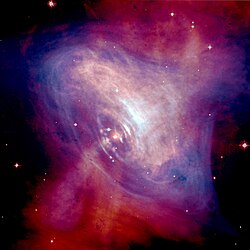Pulsarwind-Nebel

Ein Pulsarwind-Nebel (auch Plerion, von altgriechisch πλήρηςplḗrēs „voll“ – eingeführt von Weiler und Panagia)[1] ist ein charakteristisch aussehendes nebelartiges astronomisches Objekt, das im Sternwind eines Pulsars entsteht.
Dieser Pulsarwind ist ein Strom von hochenergetischen Teilchen, der durch die extremen Bedingungen in der Nähe eines Neutronensterns erzeugt wird. Unter bestimmten Bedingungen (Entstehung von Stoßwellen durch Bremsung der fast lichtschnellen Teilchen beim Eintritt in den Nebel) führt ein Pulsarwind zur Entstehung eines Pulsarwindnebels. Die Strahlung des Plerions geht über den Bereich der Stoßwelle hinaus, da es durch magnetische Felder des Pulsars zu Bildung von Synchrotronstrahlung und Jets kommt.
Der Pulsarwindnebel unterscheidet sich von normalen Supernovaüberresten dadurch, dass er keine Hüllenstruktur entwickelt, sondern zum Zentrum hin immer heller wird; das liegt am nicht-thermischen Verlauf der Synchrotronstrahlung. Als Folge dessen ist er in diversen Bereichen des elektromagnetischen Spektrums beobachtbar, meist von der Röntgenstrahlung bis hin zum Radiobereich. Ein typisches Beispiel für einen Pulsarwindnebel ist der Krebsnebel.
Abbildungen
Mithilfe des Weltraumteleskops Chandra können die nächstgelegenen Pulsarwindnebel räumlich aufgelöst abgebildet werden.
- PSR B1509-58
- G54.1+0.3
Weblinks
- Mallory S. E. Roberts: The Pulsar Wind Nebula Catalog. McGill Pulsar Group, abgerufen am 6. Juli 2009.
- Takata Jumpei: Pulsar Wind and pulsar wind nebulae. Abgerufen am 6. Juli 2009 (Präsentation; PDF-Datei; 5,17 MB).
Einzelnachweise
- ↑ Kurt W. Weiler, Nino Panagia: Are Crab-type Supernova Remnants (Plerions) Short-lived? In: Astronomy and Astrophysics. Band 70, 1978, ISSN 0004-6361, S. 419–422, bibcode:1978A&A....70..419W (englisch).
Auf dieser Seite verwendete Medien
A composite image of the Crab Nebula showing the X-ray (blue), and optical (red) images superimposed. The size of the X-ray image is smaller because the higher energy X-ray emitting electrons radiate away their energy more quickly than the lower energy optically emitting electrons as they move.
The Vela Pulsar, a neutron star corpse left from a titanic stellar supernova explosion, shoots through space powered by a jet emitted from one of the neutron star's rotational poles. Now a counter jet in front of the neutron star has been imaged by the Chandra X-ray observatory. The Chandra image above shows the Vela Pulsar as a bright white spot in the middle of the picture, surrounded by hot gas shown in yellow and orange. The counter jet can be seen wiggling from the hot gas in the upper right. Chandra has been studying this jet so long that it's been able to create a movie of the jet's motion. The jet moves through space like a firehose, wiggling to the left and right and up and down, but staying collimated: the "hose" around the stream is, in this case, composed of a tightly bound magnetic field.
A composite image from NASA's Chandra (blue) and Spitzer (green and red-yellow) space telescopes shows the dusty remains of a collapsed star, a supernova remnant called G54.1+0.3. The white source at the center is a dead star called a pulsar, generating a wind of high-energy particles seen by Chandra in blue. The wind expands into the surrounding environment. The infrared shell that surrounds the pulsar wind, seen in red, is made up of gas and dust that condensed out of debris from the supernova explosion. A nearby cluster of stars is being engulfed by the dust. The nature and quantity of dust produced in supernova explosions is a long-standing mystery, and G54.1+0.3 supplies an important piece to the puzzle.
Autor/Urheber: Smithsonian Institution from United States, Lizenz: No restrictions
Description: A long look by Chandra at 3C58 shows that the central pulsar - a rapidly rotating neutron star formed in the supernova event - is surrounded by a bright torus of X-ray emission. An X-ray jet erupts in both directions from the center of the torus, and extends over a distance of a few light years. Further out, an intricate web of X-ray loops can be seen. These features are due to radiation from extremely high-energy particles moving in a magnetic field, and show a strong resemblance to the rings, jets and loops around the Crab pulsar. The 3C58 pulsar, the Crab pulsar, and a growing list of other pulsars offer dramatic proof that strong electromagnetic fields around rapidly rotating neutron stars are powerful generators of both high-energy particles and magnetic fields.
Creator/Photographer: Chandra X-ray Observatory
NASA's Chandra X-ray Observatory, which was launched and deployed by Space Shuttle Columbia on July 23, 1999, is the most sophisticated X-ray observatory built to date. The mirrors on Chandra are the largest, most precisely shaped and aligned, and smoothest mirrors ever constructed. Chandra is helping scientists better understand the hot, turbulent regions of space and answer fundamental questions about origin, evolution, and destiny of the Universe. The images Chandra makes are twenty-five times sharper than the best previous X-ray telescope. NASA's Marshall Space Flight Center in Huntsville, Ala., manages the Chandra program for NASA's Science Mission Directorate in Washington. The Smithsonian Astrophysical Observatory controls Chandra science and flight operations from the Chandra X-ray Center in Cambridge, Massachusetts.
Medium: Chandra telescope x-ray
Date: 2004
Persistent URL: chandra.harvard.edu/photo/2004/3c58/
Repository: Smithsonian Astrophysical Observatory
Gift line: NASA/CXC/SAO/P.Slane et al.
Accession number: 3c58X-ray photograph of PSR B1509-58.







